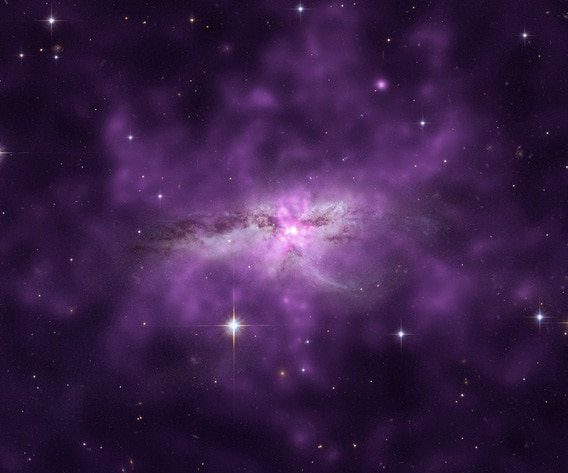Create a free profile to get unlimited access to exclusive videos, sweepstakes, and more!
Aftermath of a Colossal Cosmic Collision

Collisions between objects occur at all scales in the Universe. Asteroids impact moons and planets (and each other), gas clouds light-years across smack into each other, sometimes even stars merge after a lifetime of orbiting each other.
But one of the most impressive of these cosmic train wrecks is when two galaxies interact and collide. They may be part of a cluster, or just happen to be neighbors passing each other. But their mutual gravity can be inexorable, each drawing the other in, wreaking havoc with their structures. Eventually, they merge, forming a bigger, chaotic galaxy, until, after a billion years or so, things settle down.
A couple of hundred million years ago, two large galaxies did just this. The disastrous collision is still playing out, and the whole thing has been seen by two of the worldâs best telescopes: Hubble and Chandra.
This is NGC 6240, the two-or-kinda-one galaxies in question. Hubble sees the same kind of light our eyes see, and in this observation it detected stars, gas, and dust in the two colliding galaxies.
But the picture is dominated by Chandraâs view (shown in purple). Chandra is designed to see high-energy X-rays, a form of light created in violent events like star birth and star death. Chandra reveals the two galaxies are surrounded by a vast cloud of very hot gas, somewhere around 7.5 million Kelvins (13.5 million degrees Fahrenheit). Thatâs incredibly hot, like inside-of-a-star hot, but it's actually a cloud in deep space. And thereâs a lot of it: Itâs over 350,000 light-years across (our own galaxy is less than a third that size), and the total mass of the cloud is probably 10 billion times that of the Sun! Thatâs actually the mass of a decent-sized galaxy all by itself.
Which is a mystery. Collisions donât generate enough energy to heat that much gas that hot. They need some help.
When galaxies collide, so do their gas clouds. (Stars are very tiny on a galactic scale, and generally donât physically collide with one another.) When gas clouds smack into each other, they collapse and form stars. Those stars blast out fierce winds and a lot of energy, which can help pump up the gas in the galaxy.
Sometimes that happens in a single spasm of star birth, but thereâs evidence that the cloud surrounding NGC 6240 has been getting heated up for a long time. Itâs more likely that instead of intense, localized star formation, itâs been spread out over a wide region of both galaxies, and has been ongoing for a long time, 200 million years or so. Stars exploding at the ends of their lives have helped dump energy into the gas as well. Not only that, but there was probably an extended, cooler cloud of gas there first, and the gas being blown out by the newly formed stars is mixing with it as well, creating that fantastic and beautiful shape.
Amazingly, all of this can be gleaned from examining a few thousand photons out of the countless ones emitted by that gas. They traveled across the hundreds of millions of light-years separating us, fell into our orbiting telescopes, were recorded faithfully, and then sent down to waiting scientists.
Itâs amazing how much information we can get out of a handful of photons, the total energy of which is dwarfed by the motion of a mosquito in flight. But that tiny spark is sometimes all we need to get a clearer vision of extreme energy of the Universe in which we live.


























